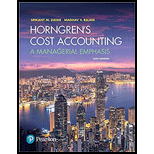
Concept explainers
Comprehensive review of Chapters 7 and 8, working backward from given variances. The Gallo Company uses a flexible budget and standard costs to aid planning and control of its machining manufacturing operations. Its costing system for manufacturing has two direct-cost categories (direct materials and direct manufacturing labor—both variable) and two
At the 50,000 budgeted direct manufacturing labor-hour level for August, budgeted direct manufacturing labor is $1,250,000, budgeted variable manufacturing overhead is $500,000, and budgeted fixed manufacturing overhead is $1,000,000.
The following actual results are for August:
| Direct materials price variance (based on purchases) | $179,300 F |
| Direct materials efficiency variance | 75,900 U |
| Direct |
535,500 |
| Variable manufacturing overhead flexible- |
10,400 U |
| Variable manufacturing overhead efficiency variance | 18,100 U |
| Fixed manufacturing overhead incurred | 957,550 |
The
In July, labor unrest caused a major slowdown in the pace of production, resulting in an unfavorable direct manufacturing labor efficiency variance of $40,000. There was no direct manufacturing labor price variance. Labor unrest persisted into August. Some workers quit. Their replacements had to be hired at higher wage rates, which had to be extended to all workers. The actual average wage rate in August exceeded the standard average wage rate by $0.50 per hour.
- A. Compute the following for August:
Required
- a. Total pounds of direct materials purchased
- b. Total number of pounds of excess direct materials used
- c. Variable manufacturing overhead spending variance
- d. Total number of actual direct manufacturing labor-hours used
- e. Total number of standard direct manufacturing labor-hours allowed for the units produced
- f. Production-volume variance
- B. Describe how Gallo’s control of variable manufacturing overhead items differs from its control of fixed manufacturing overhead items.
Want to see the full answer?
Check out a sample textbook solution
Chapter 8 Solutions
EBK HORNGREN'S COST ACCOUNTING
- Please answer the following requirements a and b on these general accounting questionarrow_forwardGeneral Accountingarrow_forwardHarper, Incorporated, acquires 40 percent of the outstanding voting stock of Kinman Company on January 1, 2023, for $210,000 in cash. The book value of Kinman's net assets on that date was $400,000, although one of the company's buildings, with a $60,000 carrying amount, was actually worth $100,000. This building had a 10-year remaining life. Kinman owned a royalty agreement with a 20-year remaining life that was undervalued by $85,000. Kinman sold Inventory with an original cost of $60,000 to Harper during 2023 at a price of $90,000. Harper still held $15,000 (transfer price) of this amount in Inventory as of December 31, 2023. These goods are to be sold to outside parties during 2024. Kinman reported a $40,000 net loss and a $20,000 other comprehensive loss for 2023. The company still manages to declare and pay a $10,000 cash dividend during the year. During 2024, Kinman reported a $40,000 net income and declared and paid a cash dividend of $12,000. It made additional inventory sales…arrow_forward
- Solve this general accounting question not use aiarrow_forwardPlease provide solution this general accounting questionarrow_forwardMichael McDowell Co. establishes a $108 million liability at the end of 2025 for the estimated site-cleanup costs at two of its manufacturing facilities. All related closing costs will be paid and deducted on the tax return in 2026. Also, at the end of 2025, the company has $54 million of temporary differences due to excess depreciation for tax purposes, $7.56 million of which will reverse in 2026. The enacted tax rate for all years is 20%, and the company pays taxes of $34.56 million on $172.80 million of taxable income in 2025. McDowell expects to have taxable income in 2026. Assuming that the only deferred tax account at the beginning of 2025 was a deferred tax liability of $5,400,000, draft the income tax expense portion of the income statement for 2025, beginning with the line "Income before income taxes." (Hint: You must first compute (1) the amount of temporary difference underlying the beginning $5,400,000 deferred tax liability, then (2) the amount of temporary differences…arrow_forward
 Principles of Cost AccountingAccountingISBN:9781305087408Author:Edward J. Vanderbeck, Maria R. MitchellPublisher:Cengage Learning
Principles of Cost AccountingAccountingISBN:9781305087408Author:Edward J. Vanderbeck, Maria R. MitchellPublisher:Cengage Learning Managerial Accounting: The Cornerstone of Busines...AccountingISBN:9781337115773Author:Maryanne M. Mowen, Don R. Hansen, Dan L. HeitgerPublisher:Cengage Learning
Managerial Accounting: The Cornerstone of Busines...AccountingISBN:9781337115773Author:Maryanne M. Mowen, Don R. Hansen, Dan L. HeitgerPublisher:Cengage Learning Managerial AccountingAccountingISBN:9781337912020Author:Carl Warren, Ph.d. Cma William B. TaylerPublisher:South-Western College Pub
Managerial AccountingAccountingISBN:9781337912020Author:Carl Warren, Ph.d. Cma William B. TaylerPublisher:South-Western College Pub Financial And Managerial AccountingAccountingISBN:9781337902663Author:WARREN, Carl S.Publisher:Cengage Learning,
Financial And Managerial AccountingAccountingISBN:9781337902663Author:WARREN, Carl S.Publisher:Cengage Learning, Cornerstones of Cost Management (Cornerstones Ser...AccountingISBN:9781305970663Author:Don R. Hansen, Maryanne M. MowenPublisher:Cengage Learning
Cornerstones of Cost Management (Cornerstones Ser...AccountingISBN:9781305970663Author:Don R. Hansen, Maryanne M. MowenPublisher:Cengage Learning




